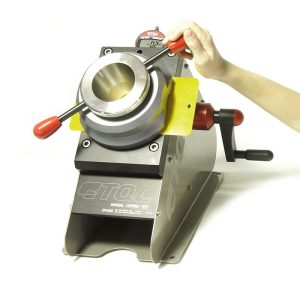Coating cracking resistance test: cup test
Cup process testing, a key coating performance evaluation method, is used to test the deformation ability of coatings, varnishes and related products under standard conditions and their ability to resist cracking or separation from metal substrates. This test method uses a cup test instrument, whose head is equipped with a spherical punch, to push the back of the paint test board at a certain constant speed, and evaluate the performance of the coating by observing whether the front coating is cracked. The result of the cup bead test is usually expressed as the minimum depth of the punch into the coating, which is called the cup bead index.

Coating cracking resistance test: cup test
The cupping test tests the ductility and deformability of a coating on a metal substrate by applying an impact under static load. According to the provisions of the national standard GB/T 9753 “Color paint and varnish cup process test”, the operation steps of the test are as follows:
First, the test plate is fixed on the cup test machine so that its surface faces outward.
Then push the punch to the test plate at a constant speed of 0.1~0.3mm/s until the coating cracks for the first time or the coating falls off the substrate.
The test results are expressed in millimeters, indicating the depth of the punch into the coating.
The importance of the cup process test is that it can help to assess the quality and performance of the coating, especially whether the coating can maintain its integrity and adhesion in the face of external pressures and shocks.
Coating cracking resistance test: cup test
1. Evaluate the cracking resistance of the coating: The cup test is mainly used to evaluate the cracking resistance of the coating. When external forces are applied to the coating, if the coating can maintain its integrity without cracking, then its cracking resistance is considered good. This is essential for the durability and service life of the coating, especially under harsh environmental conditions.
2. Anti-corrosion coatings and coating industry: cup test is widely used in anti-corrosion coatings and coating industry. The coating applied to the metal surface needs to have high cracking resistance to prevent corrosion and improve the service life of the material. By conducting cup process tests, it is possible to determine whether the coating meets industry standards and requirements.
3. Automotive and aerospace industry: In the automotive and aerospace industry, the coating needs to be able to withstand different forces and pressures, so the flexibility of the coating is high. Cup testing can help evaluate the performance of automotive and aircraft surface coatings to ensure that they remain intact under different conditions.
Coating cracking resistance test: cup test
4. Product quality control: Cup test is also commonly used in product quality control to ensure the consistency and quality of the coating. Manufacturers can verify that their products meet quality standards by conducting cup process tests to provide high-quality coated products.
In summary, cup test, as an important method of coating performance evaluation, is of great significance for coating quality control and product performance evaluation in various application fields. Through this test, it is possible to determine the performance of the coating when subjected to external shock and pressure, thus ensuring that the coating can meet the requirements of its design and use, providing more durable and reliable coating protection. Therefore, cup test plays a difficult or missing role in the coating industry.
